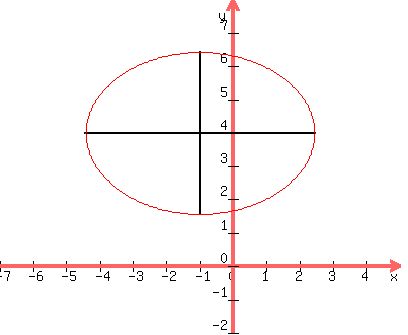Question 1208374: 1. Solve the system and graph the curves: (x + 1) ^ 2 + 2 * (y - 4) ^ 2 = 12; y ^ 2 - 8y = 4x - 16
Found 2 solutions by Edwin McCravy, ikleyn:
Answer by Edwin McCravy(20077)   (Show Source): (Show Source):
You can put this solution on YOUR website!
The first equation can be placed in one of the standard forms of an ellipse:
 or or  The value of " a " is the length of the semi-major axis and the value " b " is
the length of the semi-minor axis. The major axis is always longer than the
minor axis.
If the number under the (x-h)2 is greater than the number under
the (y-k)2, the ellipse will look like this:
The value of " a " is the length of the semi-major axis and the value " b " is
the length of the semi-minor axis. The major axis is always longer than the
minor axis.
If the number under the (x-h)2 is greater than the number under
the (y-k)2, the ellipse will look like this: And If the number under the (y-k)2 is greater than the number under
the (x-h)2, the ellipse will look like this:
And If the number under the (y-k)2 is greater than the number under
the (x-h)2, the ellipse will look like this:  The center is the point (h,k).
You must memorize the above, and the facts about all the conic sections if you
expect to be successful doing conic section problems. You can't figure them out
or look them up every time. You won't have time on a test or exam.
The center is the point (h,k).
You must memorize the above, and the facts about all the conic sections if you
expect to be successful doing conic section problems. You can't figure them out
or look them up every time. You won't have time on a test or exam.
 Divide through by 12 to get 1 on the right:
Divide through by 12 to get 1 on the right:

 so the center is (-1,4), the 12 is larger than the 6, so the ellipse looks
like this:
so the center is (-1,4), the 12 is larger than the 6, so the ellipse looks
like this:  . .
 , so , so  , ,
 , so , so  ,
We plot the center (-1,4), and the major and minor axes: ,
We plot the center (-1,4), and the major and minor axes:
 Then sketch in the ellipse:
Then sketch in the ellipse:
 The other one is a parabola. I'll do it later if another tutor doesn't
do it first. Then we'll have to solve the system of equations and find
their points of intersection, and graph both on the same set of
coordinate axes. Maybe one of the other tutors will finish.
Edwin
The other one is a parabola. I'll do it later if another tutor doesn't
do it first. Then we'll have to solve the system of equations and find
their points of intersection, and graph both on the same set of
coordinate axes. Maybe one of the other tutors will finish.
Edwin
Answer by ikleyn(53419)   (Show Source): (Show Source):
You can put this solution on YOUR website! .
1. Solve the system and graph the curves: (x + 1) ^ 2 + 2 * (y - 4) ^ 2 = 12; y ^ 2 - 8y = 4x - 16
~~~~~~~~~~~~~~~~~~~~~~
Starting equations are
(x+1)^2 + 2*(y-4)^2 = 12, (1)
y^2 - 8y = 4x - 16. (2)
Rewrite equation (2) this way
y^2 - 8y + 16 = 4x,
(y-4)^2 = 4x. (3)
Now replace the term 2*(y-4)^2 in equation (1) by 2*(4x), based on equation (3).
You will get simple quadratic equation for single unknown x
(x+1)^2 + 8x = 12.
Write it in the standard form and solve by factoring
(x+1)^2 + 8x - 12 = 0,
x^2 + 2x + 1 + 8x - 12 = 0,
x^2 + 10x - 11 = 0,
(x+11)*(x-1) = 0.
The roots are x= -11 and x= 1.
For x= -11, the corresponding values of y are
(y-4)^2 = 4*(-11) (from equation (3)
y-4 = +/-  , y = , y =  <<<---=== complex values
For x= 1, the corresponding values of y are
(y-4)^2 = 4*1 (from equation (3)
y-4 = +/- 2,
which implies
y = 4 + 2 = 6 or y = 4 - 2 = 2.
Thus the given system (1), (2) has two real solutions (x.y) = (1,6) and (x,y) = (1,2).
ANSWER. The given system (1), (2) has two real solutions (x.y) = (1,6) and (x,y) = (1,2).
Equation (1) describes an ellipse; equation (2) describes a parabola
having the horizontal axis, and these two curves have two intersection points (1,6) and (1,2). <<<---=== complex values
For x= 1, the corresponding values of y are
(y-4)^2 = 4*1 (from equation (3)
y-4 = +/- 2,
which implies
y = 4 + 2 = 6 or y = 4 - 2 = 2.
Thus the given system (1), (2) has two real solutions (x.y) = (1,6) and (x,y) = (1,2).
ANSWER. The given system (1), (2) has two real solutions (x.y) = (1,6) and (x,y) = (1,2).
Equation (1) describes an ellipse; equation (2) describes a parabola
having the horizontal axis, and these two curves have two intersection points (1,6) and (1,2).
Solved.
To make plots, go to website www.desmos.com/calculator
It has free of charge plotting tool for common use.
Print your equations there and get the graphs instantly.
|
|
|